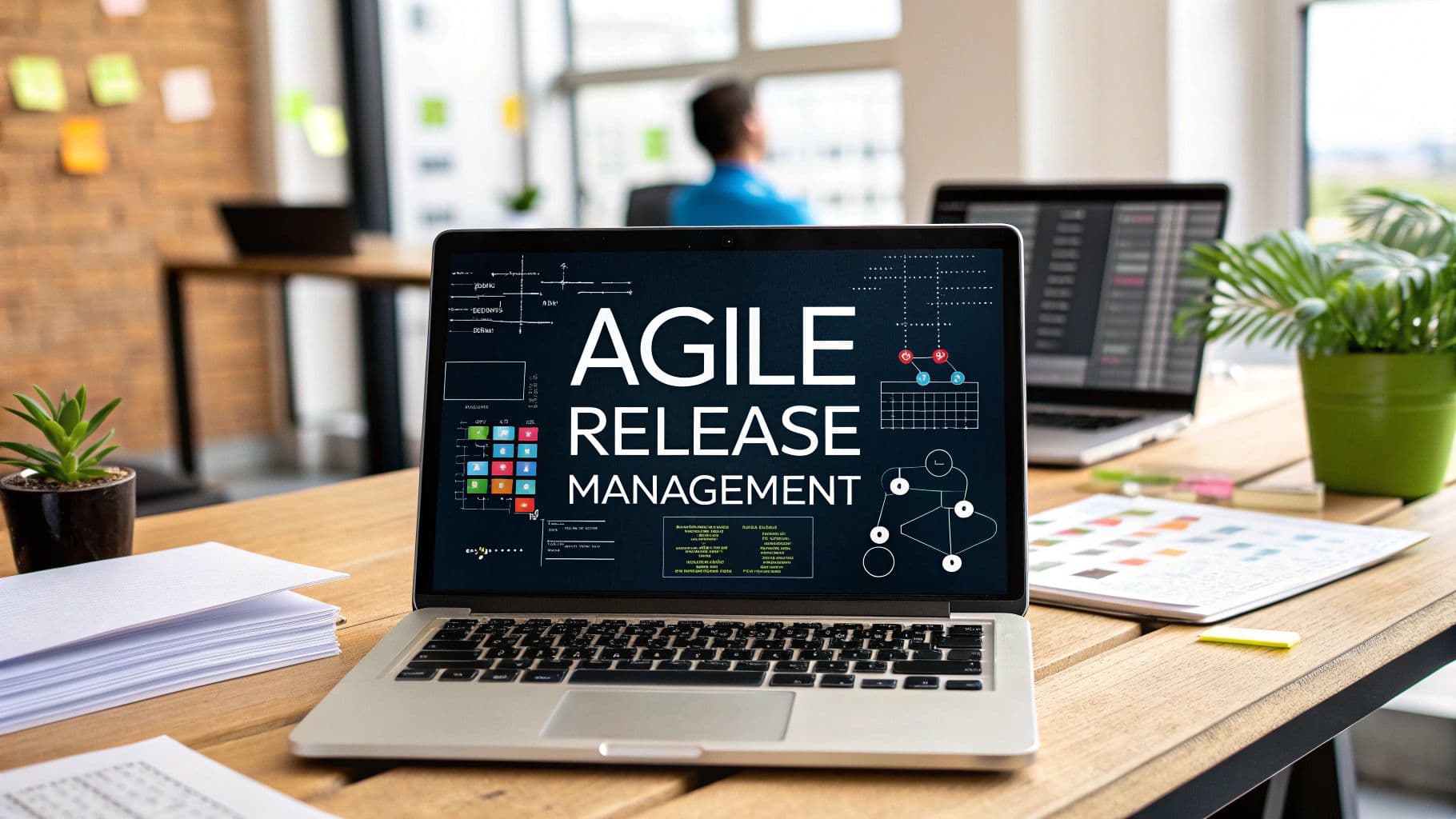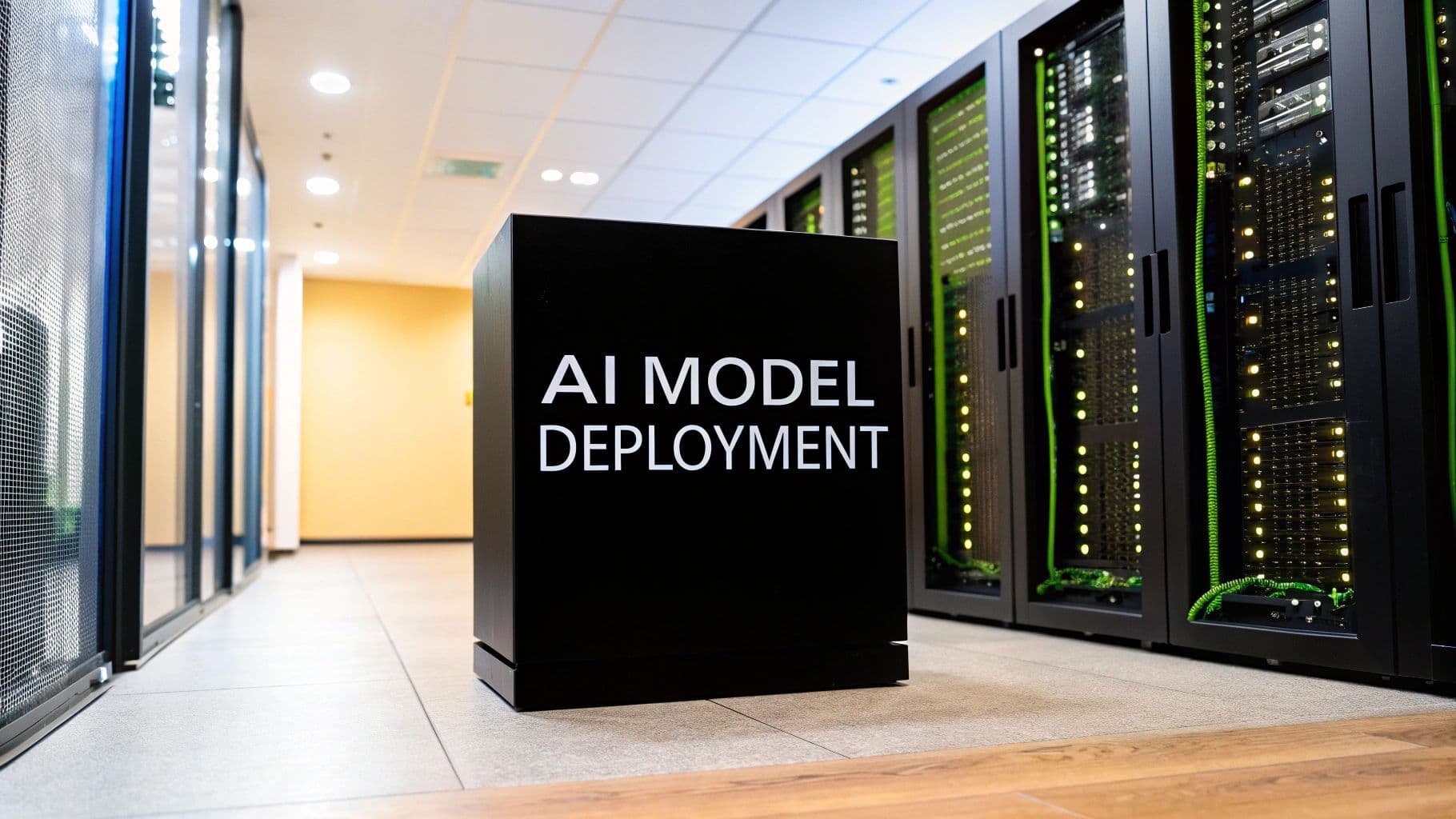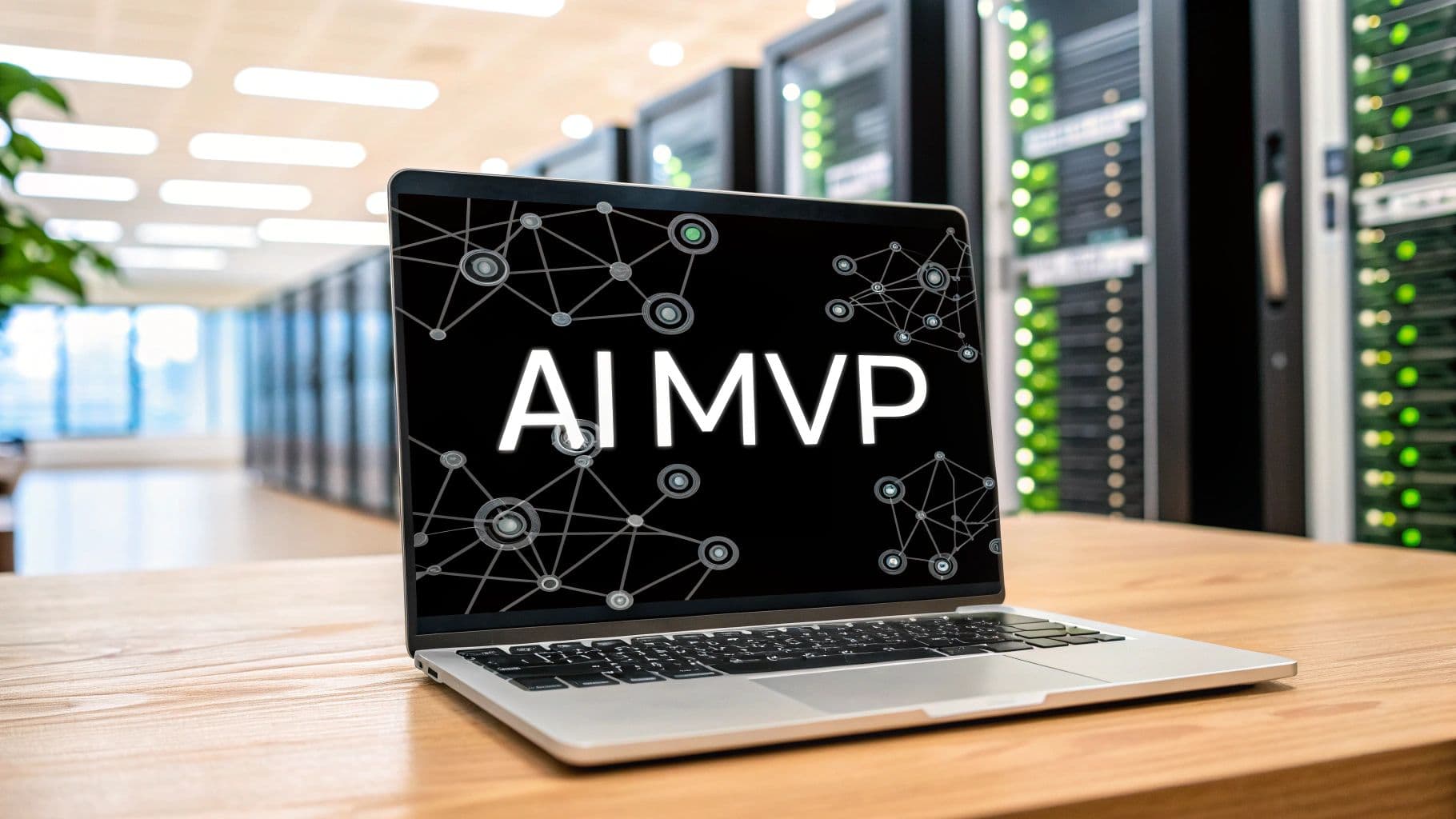MVP development process
lean startup
product validation
agile development
startup costs
Master the MVP Development Process for Faster Success
Why the MVP Development Process Actually Works

The MVP (Minimum Viable Product) development process has become a cornerstone of modern product development. But why does this approach, focused on launching with minimal features, actually work? The answer lies in its ability to validate core assumptions, accelerate time to market, and optimize resource allocation. It's not about releasing an unfinished product; it’s about strategically building just enough to learn and iterate quickly.
Validating Your Vision Early and Often
One of the most compelling reasons to embrace the MVP development process is its focus on early validation. Think of your product idea as a hypothesis. The MVP is like a scientific experiment designed to test that hypothesis with real-world data on user behavior and market demand. This prevents investing significant resources into a potentially flawed concept.
Imagine developing a complex social media platform. After launch, you discover your target audience prefers a different communication style. A well-designed MVP could have revealed this crucial insight much earlier, saving valuable time and money.
The Power of Strategic Minimalism
Another key advantage of the MVP approach is its emphasis on strategic minimalism. By focusing on only the essential features, you can streamline your development timeline and reduce costs. This enables you to enter the market faster, gain a competitive edge, and begin collecting user feedback sooner.
Instead of relying on assumptions, you adapt and evolve your product based on real-world usage. This agility is particularly valuable in today's dynamic market where user preferences can change rapidly. You might be interested in: How to master MVP Development with AI.
Adapting to the Evolving Landscape
The MVP development process itself is constantly evolving, driven by emerging trends. These advancements enable faster development cycles and improved product-market fit. The integration of AI and lean methodologies further enhances the MVP’s effectiveness.
For instance, AI can personalize user experiences and optimize product functionality, while lean principles streamline development processes and eliminate waste. Learn more about current MVP development trends. This continuous evolution ensures that the MVP development process remains a powerful tool for product teams.
Navigating the Critical Phases of MVP Development
Every successful Minimum Viable Product (MVP) begins with a clear path, guiding its journey from initial concept to market launch. Let's explore each critical phase of the MVP development process: ideation, planning, design, development, testing, and deployment. We'll delve into the essential deliverables of each stage, emphasizing a user-centric approach to maximize value and avoid feature creep.
Ideation and Conceptualization: Defining Your Vision
The ideation phase is where your MVP takes shape. It starts with identifying the core problem your product will address. Brainstorming potential solutions and formulating a concise problem statement are crucial. This statement becomes your guiding principle throughout development, ensuring alignment between the problem and your proposed solution. This focused approach sets the stage for an effective MVP. You might be interested in: How to master AI Prototyping Tools.
Planning and Strategy: Building a Roadmap
With a clear vision, the planning phase transforms ideas into a concrete roadmap. This stage involves market research to understand your target audience, feature prioritization to focus on essential functionalities, and technical specification drafting to prepare for development. The following infographic illustrates a typical planning stage timeline.
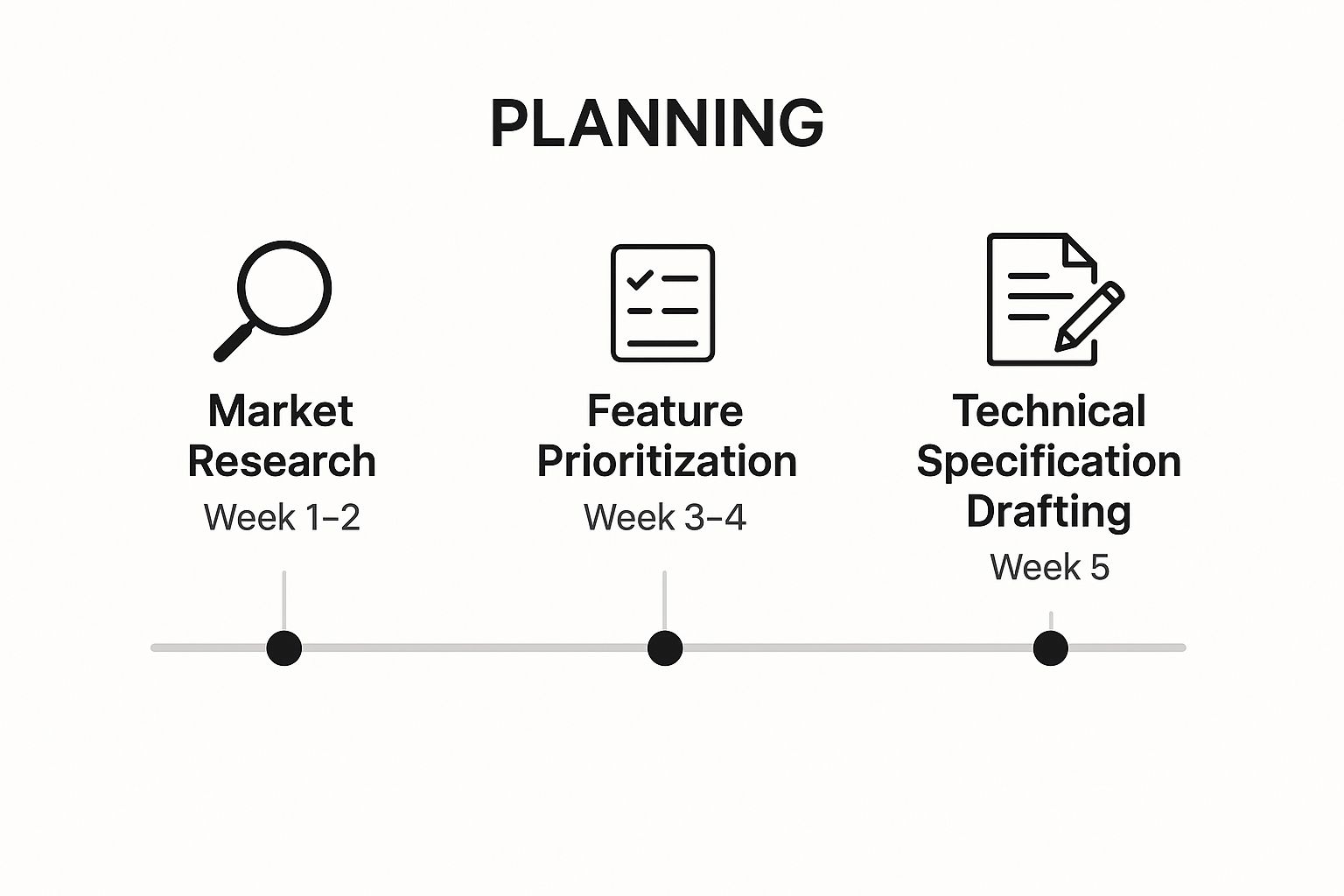
As the infographic highlights, the planning stage consists of interconnected milestones. This structure ensures a deep understanding of the market, carefully prioritized features, and a clear technical plan before moving into design. The MVP development timeline can vary significantly depending on complexity and scope. A basic MVP can often be developed within three to four months, facilitating rapid market entry and feedback collection. More complex projects may require six to twelve months for a foundational MVP, or up to twenty-four months for comprehensive solutions. Learn more about MVP timelines.
To further clarify typical MVP development timelines, let's look at a breakdown:
MVP Development Timeline Breakdown This table outlines the typical duration of each phase in the MVP development process for projects of varying complexity.
| Development Phase | Simple MVP (weeks) | Medium Complexity (weeks) | Complex MVP (weeks) |
|---|---|---|---|
| Ideation & Conceptualization | 2 | 4 | 6 |
| Planning & Strategy | 3 | 6 | 8 |
| Design & UX | 4 | 8 | 12 |
| Development | 6 | 12 | 24 |
| Testing & Validation | 2 | 4 | 6 |
| Deployment & Iteration | 1 | 2 | 4 |
| Total | 18 | 36 | 52 |
This table provides a general guideline. Actual timelines can vary based on specific project requirements. It's important to prioritize thorough planning and testing to ensure a successful MVP launch.
Design and User Experience: Crafting the Interface
The design phase brings your MVP to life visually, focusing on user-friendly interfaces and intuitive experiences. This involves creating wireframes, mockups, and prototypes to visualize the product’s functionality and flow. User feedback is crucial at this stage, refining the design and aligning it with user expectations.
Development: Building the Core
With the design finalized, the development phase begins, involving coding the core features, integrating necessary APIs, and building the backend infrastructure. The goal is a functional product with the essential elements ready for testing and user feedback.
Testing and Validation: Refining Your Product
Testing is an ongoing process, becoming especially critical after the initial build. This phase includes usability testing, functional testing, and performance testing. The resulting insights help identify bugs, improve user experience, and validate assumptions about the product’s value.
Deployment and Iteration: Launching and Learning
Deployment marks your MVP’s official launch. However, the real work starts post-launch, with continuous monitoring, feedback collection, and iteration based on real-world user data. Remaining adaptable and iterating based on market response is key to building a product that resonates with your target audience.
Realistic Budgeting for Your MVP Journey
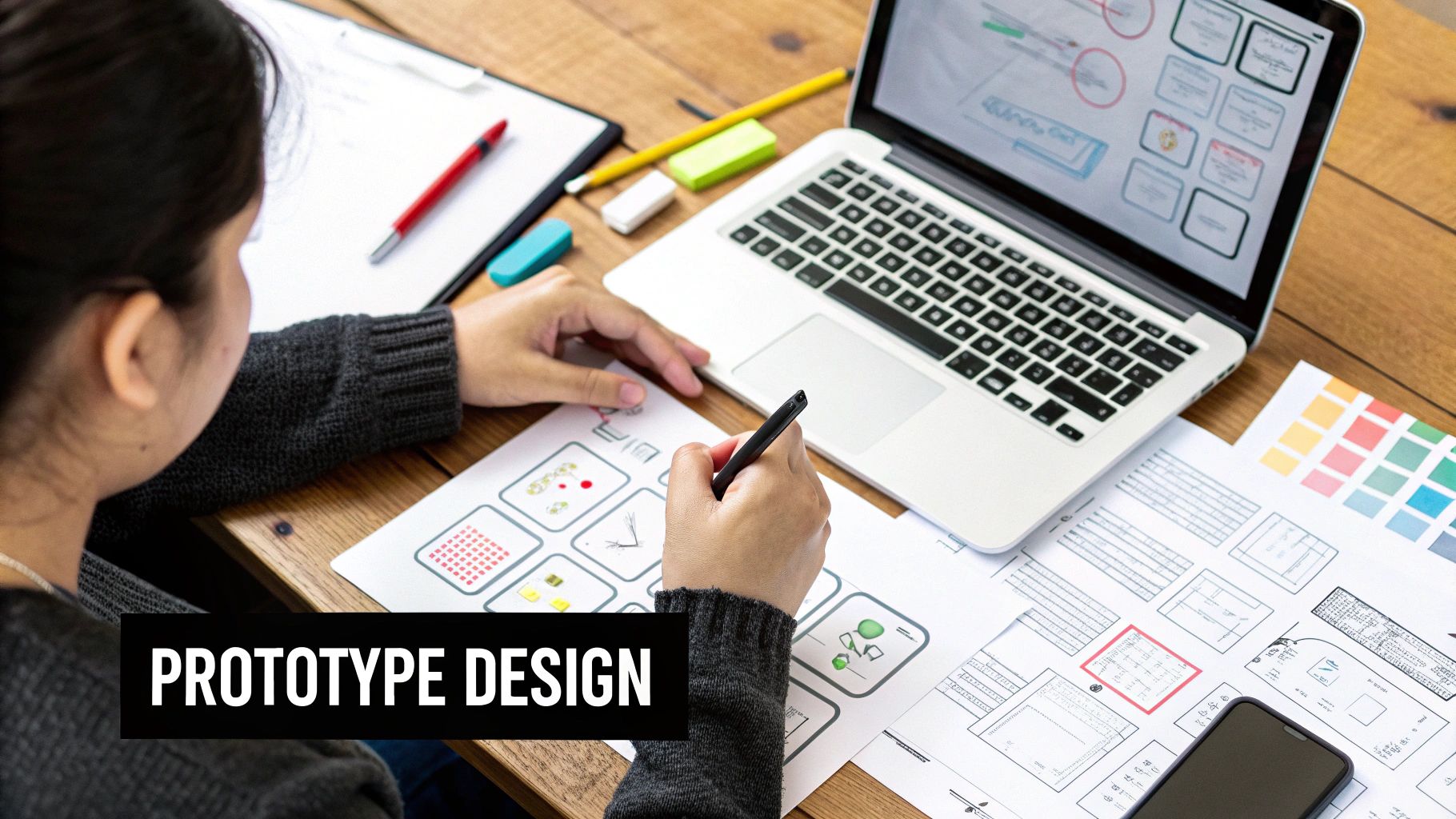
One of the biggest questions when developing a Minimum Viable Product (MVP) is the cost. Understanding the financial commitment is essential for planning, securing funding, and ultimately, the success of your MVP. This section offers clear guidance on estimating expenses, allocating resources effectively, and managing your budget throughout development.
Estimating Your MVP Development Costs
Accurate cost estimation is the first step in realistic budgeting. Several key factors influence the total expense.
-
Complexity of Features: Simple features, like basic logins, cost less to develop than complex features, like real-time data processing or integrating Artificial Intelligence (AI).
-
Team Structure: Hiring freelancers may be cheaper initially, but managing multiple individuals can create communication overhead. An in-house team provides more control, but salaries and benefits are higher. Outsourcing to a development agency can offer a balance of expertise and cost-effectiveness.
-
Technology Stack: Choosing the right technologies impacts development speed and cost. Using open-source libraries and frameworks can save time and money.
-
Design and UX: A well-designed user interface is crucial for a positive user experience. However, complex animations and custom design elements can increase costs.
Understanding these factors helps make informed decisions about features and development approach. The cost of developing an MVP can vary significantly. In 2025, the average cost ranges from $15,000 to $150,000 or more, depending on factors like team structure and project complexity. Historically, costs have been affected by technological advancements and market demands. Learn more at MVP Development Cost.
Prioritizing Features for Maximum Value
Prioritizing features based on development cost versus potential business value is crucial for staying on budget. Ask yourself these key questions:
-
Essential Features: Which features are absolutely necessary to validate your core hypothesis?
-
Deferrable Features: Which features can be added later without affecting the MVP's core functionality?
-
Cost vs. Return: What is the estimated cost of each feature, and does its potential return justify the investment?
This analysis helps focus resources on the most impactful features, maximizing value while minimizing expense.
Managing Cash Flow and Avoiding Budget Overruns
Maintaining healthy cash flow is essential during MVP development. This involves several key practices:
-
Detailed Budget: Itemize expenses into categories like development, design, testing, and marketing.
-
Track Spending: Regularly monitor expenses and compare them to your budget.
-
Contingency Funds: Allocate funds for unexpected costs.
Proactive financial management helps avoid surprises and keeps development on track.
Maximizing Value Within Your Budget
Building an MVP is about maximizing value with limited resources. This involves strategic trade-offs and smart prioritization. By focusing on core functionalities, choosing the right team, and actively managing your budget, you can create a successful MVP. This validates your business idea without overspending and sets the stage for future growth and iteration, building a product that resonates with your target audience.
Building Your MVP Dream Team (Without Breaking the Bank)
Assembling the right team is crucial for a successful Minimum Viable Product (MVP) development process. This involves identifying key roles, understanding different team structures, and establishing effective communication. Let's explore how to build a high-performing MVP team without overspending.
Essential Roles for MVP Development
A lean, efficient team is key for MVP development. While the exact composition depends on the project, certain roles are typically essential:
-
Product Manager: The visionary leader who defines the product strategy, prioritizes features, and ensures alignment with the overall vision. This role acts as the central point of contact, guiding the development process and making key decisions.
-
UX/UI Designer: Responsible for crafting user-friendly interfaces and seamless user experiences. They translate user needs into intuitive designs, creating wireframes, mockups, and prototypes that guide the development team.
-
Software Developers: The builders who bring the MVP to life through code. They translate the design into a functional product, focusing on the core features essential for the MVP. A full-stack developer can handle both front-end and back-end tasks, streamlining the development process for a lean team.
-
QA Tester: Ensures the quality and functionality of the MVP by identifying bugs and usability issues before launch. This role is critical for catching potential problems early and delivering a polished MVP.
Choosing the Right Team Structure
Different team structures exist, each with its own advantages and disadvantages:
-
In-House Team: Offers greater control and direct communication. However, it comes with higher costs associated with salaries and benefits.
-
Outsourcing: Provides access to specialized skills and can be more cost-effective. However, it requires careful management of communication and project timelines.
-
Hybrid Approach: Combines the benefits of both in-house and outsourced teams, allowing for flexibility and cost optimization.
The best team structure depends on project complexity, budget constraints, and long-term goals. For example, a complex MVP requiring specialized expertise might benefit from a hybrid approach, leveraging in-house talent for core functionalities and outsourcing specialized tasks. Conversely, a simple MVP with a limited budget might be better suited for an outsourced team. Once you have a solid understanding of your product and target audience, focus on finding the right individuals. Check out this helpful article on how to build a startup team.
Effective Communication and Collaboration
Clear communication and efficient collaboration are essential for any MVP team. This involves:
-
Regular Meetings: Keep the team aligned on progress, identify roadblocks, and ensure everyone is working towards the same goals.
-
Project Management Tools: Utilize tools like Trello or Asana to track tasks, manage deadlines, and facilitate communication.
-
Clearly Defined Roles and Responsibilities: Ensure each team member understands their specific responsibilities and how their work contributes to the overall project.
By fostering a collaborative environment and maintaining open communication channels, you can ensure a smooth and efficient MVP development process. A well-structured team, coupled with clear communication, can deliver exceptional MVPs even with limited resources. This proves that a smaller, focused team can often achieve more than a larger, less organized group.
Implementing Agile to Supercharge Your MVP Development
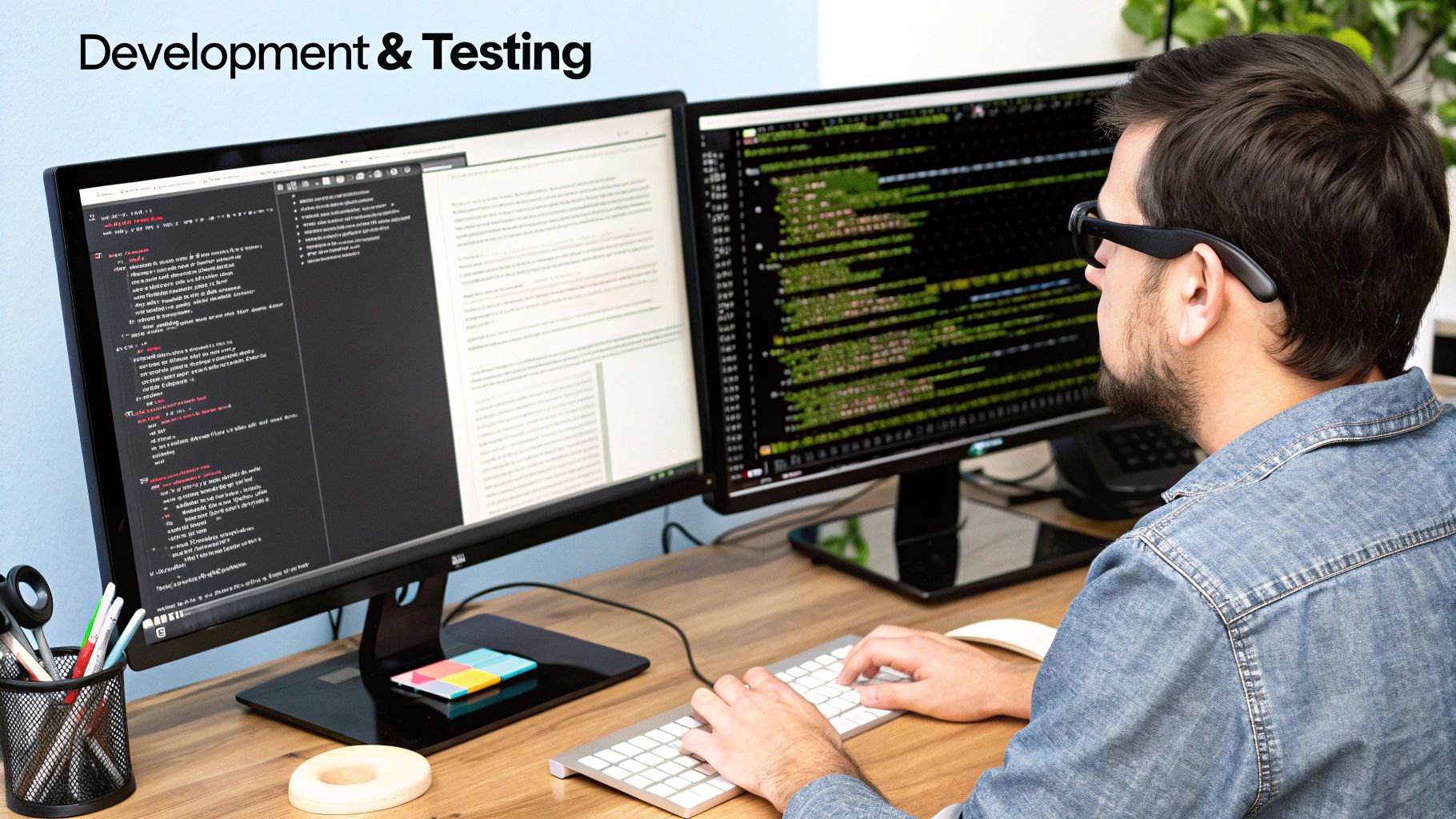
Agile methodologies are powerful tools for enhancing MVP development. By understanding and properly applying these frameworks, teams can create more user-centric products, improve collaboration, and streamline the entire development lifecycle.
Understanding Agile Frameworks for MVPs
Two common agile frameworks used in MVP development are Scrum and Kanban. Scrum uses short, iterative development cycles called sprints, typically 1-4 weeks long. This allows for regular feedback and adjustments throughout the process.
Kanban, in contrast, focuses on visualizing the workflow and limiting work in progress. This approach facilitates continuous delivery and helps reduce bottlenecks. The best framework for your project depends on several factors including team size, project complexity, and the desired level of structure. Assembling the right team is also a critical component of success. For insights on building a strong startup team, check out this helpful resource: build a startup team.
To help you choose the best framework, let's take a closer look at a comparison of Scrum and Kanban.
The following table, "Comparing Agile Frameworks for MVP Development," provides a detailed comparison of different agile methodologies and their suitability for various types of MVP development projects.
| Agile Framework | Best For | Team Size | Planning Focus | Iteration Length | Key Advantages |
|---|---|---|---|---|---|
| Scrum | Complex projects requiring frequent adaptation | Small to medium (3-9 members) | Sprint planning and backlog refinement | 1-4 weeks (Sprints) | Enhanced collaboration, increased flexibility, faster time to market |
| Kanban | Continuous delivery and workflow visualization | Flexible team size | Visualizing workflow and limiting work in progress | Continuous flow | Reduced bottlenecks, improved efficiency, increased transparency |
This table highlights the key differences between Scrum and Kanban, offering a clearer understanding of which framework best aligns with specific project requirements.
Applying Agile Principles in Practice
Adopting agile goes beyond simply choosing a framework; it involves embracing core principles. These principles are fundamental to maximizing the benefits of agile during MVP development.
Sprint planning in Scrum, for example, defines the scope of work for each sprint based on prioritized user stories. This helps the team focus on delivering value in each iteration. User stories are concise descriptions of desired functionality from a user's perspective, emphasizing the why behind each feature. This user-centric approach keeps development aligned with user needs.
Incremental delivery, releasing functional parts of the MVP at the end of each sprint, enables early feedback and validation. This iterative process helps refine the product and ensures it meets user expectations.
Finding the right balance between agile flexibility and structure is vital. While adaptability is important, clear documentation and defined processes are still essential for maintaining project clarity and preventing scope creep. This balance ensures the team can effectively respond to changes while staying on track towards the overall MVP goals.
The right agile approach depends on your specific MVP scenario, considering factors such as project complexity, team size, and the desired balance between flexibility and structure. By understanding these nuances, you can tailor your agile implementation for optimal results.
Testing That Actually Improves Your MVP
Testing isn't just the last step when building an MVP; it's woven into the entire process. Effective testing from the outset ensures your MVP delivers real value to users, laying the foundation for future success. The key lies in balancing thorough testing with the fast-paced nature of MVP development.
Targeted Testing Approaches for MVPs
Testing an MVP is different from testing a fully developed product. Instead of exhaustively checking every single scenario, focus on critical path validation. This means concentrating on the core features that make your MVP valuable.
-
Functional Testing: Make sure the core features function as expected. If you're building a food delivery app, this means verifying users can browse restaurants, add items to their cart, and complete an order.
-
Usability Testing: See how easily users navigate your MVP and accomplish their goals. Observe real users interacting with the product and pinpoint any frustrating or confusing parts of the user experience.
-
Performance Testing: Evaluate how fast and responsive your MVP is under various conditions. For a social media app, this could involve checking load times for the newsfeed with a large number of users or posts.
By focusing on these targeted approaches, you can gain valuable insights without slowing down your MVP development.
Efficient Testing Methodologies for Speed
Maintaining a rapid development pace requires efficient testing methods specifically for MVPs.
-
A/B Testing: Compare two different versions of a feature to determine which performs better. You might test two different call-to-action buttons on your landing page to identify the one that generates more conversions.
-
User Feedback Collection: Set up systems for gathering direct input from your users. This could involve in-app surveys, feedback forms, or even dedicated social media groups for your MVP.
-
Beta Testing: Release a beta version of your MVP to a select user group for real-world testing. This allows for valuable feedback in a controlled setting before your official launch. Consider resources like this one on CI/CD best practices to further streamline your MVP development process.
These methods allow for continuous improvement and ensure your MVP evolves based on real user data.
Turning User Feedback into Actionable Insights
Collecting feedback is only useful if you act on it. Create a structured process for analyzing and prioritizing the feedback you receive. This might involve sorting it by type, severity, and frequency. For example, numerous reports of difficulty completing a particular action suggest a high-priority usability problem. A successful MVP isn't static; it evolves based on user needs and preferences. Consistent, thoughtful testing throughout development is the key. This ensures you're focused on the improvements that have the biggest impact on the user experience.
From MVP Launch to Market Success: The Path Forward
Launching your Minimum Viable Product (MVP) is a big step, but it's just the beginning. Turning that initial release into a successful product requires strategic iteration, user feedback, and a focus on sustainable growth.
Establishing Effective Feedback Loops
Getting user feedback is crucial after launch. Set up systems to collect both quantitative data (like usage patterns and conversion rates) and qualitative data (like user reviews and survey responses). This gives you a complete picture of how users interact with your MVP and what improvements are most important to them.
For example, a significant drop in user engagement on a particular screen could indicate a usability problem worth investigating.
Prioritizing Feature Enhancements
Features aren't all equal. Prioritize enhancements based on their potential impact on user satisfaction and business goals. Your feedback data will highlight areas for improvement.
If users consistently request a specific feature, prioritizing its development can significantly boost user satisfaction and drive adoption. This data-driven approach ensures you’re investing in features that deliver real value. Check out our guide on How to build a micro-saas for more on maximizing impact.
Maintaining Development Momentum
It's easy for development momentum to slow down post-launch. Clear roadmaps and sprint cycles help maintain a consistent pace of improvement. This prevents stagnation and ensures your MVP keeps evolving based on user needs.
Regularly celebrating small wins and acknowledging team contributions also keeps morale high and everyone focused on the long-term vision.
Data-Driven Decision Making for MVP Success
Use data analytics to guide decisions about feature development, enhancements, and even removal. This avoids relying on internal biases and keeps decisions aligned with actual user behavior.
Analyzing feature usage data, for instance, can reveal underutilized features or those contributing to user frustration, allowing you to simplify the user experience.
Managing Technical Debt and Future Growth
As your MVP evolves, so will its underlying architecture. Address technical debt proactively to avoid accumulating problems that hinder future development. This means refactoring code, optimizing database performance, and implementing robust testing.
Building a scalable architecture from the start is key for sustained growth. This might involve using cloud-based infrastructure, modular design principles, and automated testing and deployment pipelines.
By focusing on continuous improvement, data-driven decisions, and managing technical debt, you can turn your MVP into a winning product. This ongoing process is essential for sustained growth and building a product that resonates with your target audience.
Ready to accelerate your AI-powered SaaS development? AnotherWrapper, our comprehensive AI starter kit, lets you launch projects in hours. Skip repetitive setup and focus on product innovation with our customizable demo applications, built-in services, and robust UI components. Launch your next project with AnotherWrapper today!
Fekri


